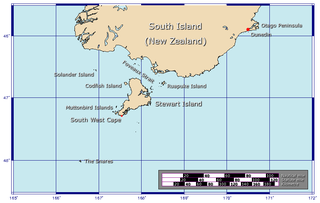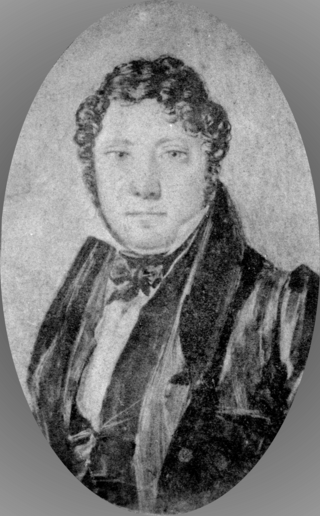D'Arcy Wentworth was an Irish-Australian surgeon and the first paying passenger to arrive in the new colony of New South Wales. He served under the first seven governors of the Colony, and from 1810 to 1821, he was "great assistant" to Governor Lachlan Macquarie. Wentworth led a campaign for the rights and recognition of emancipists and for trial by jury.

Ruapuke Island is one of the southernmost islands in New Zealand's main chain of islands. It lies 15 kilometres (9.3 mi) to the southeast of Bluff and 32 kilometres (20 mi) northeast of Oban on Stewart Island/Rakiura. It was named "Bench Island" upon its discovery by Captain James Cook in 1770, but has rarely been known by any other name than its Māori name, which means "two hills". Ruapuke Island was called Goulburn Island by Captain John Kent, named after Frederick Goulburn, a Government official in New South Wales, but the whalers generally called it Long Island, or Robuck. The island covers an area of about 16 km2 (6 sq mi). It guards the eastern end of Foveaux Strait.
James Kelly (1791–1859) was an Australian mariner, explorer and port official.
Governor Hunter was a 35 tons schooner built by Isaac Nichols in Sydney and launched 17 January 1805. She was registered in Sydney on 18 January 1805. During a gale in July 1816, she was wrecked on the East coast of Australia.
Trial was a ship that first appears in Australian newspaper records in 1808 and that was seized by convicts and eventually wrecked on the Mid North Coast of New South Wales, Australia in 1816.
William Cossar was a small 20 ton wooden New South Wales Colonial Government schooner that was wrecked in 1825.
Charlotte Badger was a former convict who was on board the Venus during a mutiny in Tasmania in 1806. Taken to New Zealand, she was rescued by Captain Turnbull of the Indispensible, and eventually she returned to Sydney. In the intervening centuries, a number of writers have contributed to the fiction that she took an active role in the mutiny and she became known – erroneously – as Australia's first female pirate.

Elizabeth Reef, located at 29°57′25″S159°4′32″E, is a coral reef in the Coral Sea. The reef is separated by a deep oceanic pass, some 47 km wide, from nearby Middleton Reef, both of which are part of the underwater plateau known as the Lord Howe Rise. It is around 150 km from Lord Howe Island and 600 km from the New South Wales coast of Australia. The Environment, Sport and Territories Legislation Amendment Act 1997 included Elizabeth Reef in Australia's Coral Sea Islands Territory.
Admiral Gifford was a wooden schooner that was lost while travelling between Port Macquarie and Sydney, New South Wales, on 8 October 1834 with a cargo of grain, hides and tallow.
John Grono was a settler, sailor, ship builder, ship captain, sealer, whaler and farmer who migrated to Australia in 1799 from Wales. Captaining the ship Governor Bligh, he would later go on to be the first European to fully explore and name parts of the southwestern coast of New Zealand's south island including Milford Sound, Bligh Sound and Elizabeth Island.
Belinda was a brig that was wrecked in 1824 off the coast of Western Australia.

Captain John Dibbs was a master mariner prominent during 1822–1835 in the seas around the colony of New South Wales, New Zealand and the Society Islands. Dibbs was master of the colonial schooner Endeavour 1822–1824, the brig Haweis 1824–1827 and the barque Lady Blackwood 1827–1834. He is credited as the European discoverer of Rarotonga and several other islands. Most of his voyages involved the transporting of missionaries, trade, whaling and seal hunting. He was believed for over 170 years to have disappeared at sea in 1835. He was the father of Sir George Dibbs, a pre-Federation Australian politician, Sir Thomas Dibbs, an Australian banker, and John Campbell Dibbs, a successful Sydney businessman.
Francis was a 41 tons (bm) colonial schooner that was partially constructed at the Deptford Dockyard, England, and sent in frame aboard the Pitt to Australia to be put together for the purposes of exploration. The vessel had originally been designed for George Vancouver’s discovery voyage of the west coast of North America.
Sun was a brig built in 1819 at Sunderland and was condemned at the Cape of Good Hope in August 1822. She was repaired and began sailing east of the Cape. She was wrecked in May 1826 in the Torres Strait.

Cyprus was a brig launched at Sunderland in 1816. The colonial government in Van Diemen's Land purchased her in 1826. In 1829 as she was transporting convicts from Hobart Town to Macquarie Harbour Penal Station, some of the convicts seized Cyprus. They sailed her via Japan to Canton, where they scuttled her.
Richard Siddins (1770–1846) was an Australian Master Mariner, Harbour Pilot and Lighthouse Keeper.
Calder was a brig launched in 1821 at Calcutta. A new owner in 1822 sailed her to Australia and she then traded in the Pacific until in 1825 she sailed to Chile and was wrecked at Valparaiso. There a new owner salvaged her and returned her to sailing under the name Indefatigable. On Indefatigable's first voyage the Chilean members of her crew mutinied, killing her captain. The mutineers sailed to Guam where the authorities took Indefatigable in prize. She was later lost in a typhoon in the China Sea.
Spring Grove was a Spanish vessel, launched in 1801, that had been taken in prize in 1806 and that her new owners had renamed. She made six voyages as a Southern Whale Fishery whaler before she wrecked in 1824 on the outbound leg of what was to have been her seventh voyage.
HM Colonial brig Prince Leopold was launched in 1815, or earlier, as Rosetta. The government in Van Diemen's Land (VDL) purchased her in 1818 to serve the settlements. She then carried timber other supplies, and transferred both prisoners and soldiers between VDL and Port Jackson, and to and from Maria Island. In July 1831 the government sold the brig. Her new owners named her Mary Elizabeth, or Mary and Elizabeth. She was wrecked on 30 May 1835 at Port Sorell, Tasmania.
Caroline was launched at Philadelphia in 1800. She was taken in prize. New owners retained her name and she appeared in British records from 1813. From 1820 on she was based at Hobart in Van Diemen's Land. From there she sailed to and from Port Jackson and on seal hunting voyages to Macquarie Island. She departed on a sealing voyage in November 1824 and wrecked at Macquarie Island on 17 March 1825; her crew were rescued some five months later.



